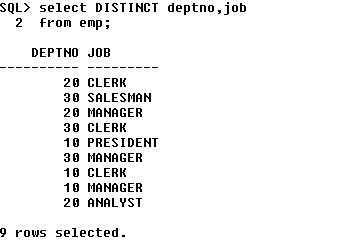What
is RDBMS?
RDBMS stands for Relational Database Management System. RDBMS is the basis
for SQL, and for all modern database systems like MS SQL Server, IBM DB2,
Oracle, MySQL, and Microsoft Access.
A Relational database
management system (RDBMS) is a database management system (DBMS) that is based
on the relational model as introduced by E. F. Codd.
What
is table ?
The data in RDBMS is stored in database
objects called tables. The table is a collection of related data
entries and it consists of columns and rows.
Remember, a table is the
most common and simplest form of data storage in a relational database.
Following is the example of a CUSTOMERS table:
+----+----------+-----+-----------+----------+
| ID
|
NAME |
AGE | ADDRESS
| SALARY
|
+----+----------+-----+-----------+----------+
| 1 | Ramesh | 32 | Ahmedabad | 2000.00 |
| 2 | Khilan | 25 | Delhi | 1500.00 |
| 3 | kaushik | 23 | Kota | 2000.00 |
| 4 | Chaitali | 25 | Mumbai | 6500.00 |
| 5 | Hardik | 27 | Bhopal | 8500.00 |
| 6 | Komal | 22 |
MP | 4500.00 |
| 7 | Muffy | 24 | Indore | 10000.00 |
+----+----------+-----+-----------+----------+
What
is field?
Every table is broken up
into smaller entities called fields. The fields in the CUSTOMERS table consist
of ID, NAME, AGE, ADDRESS and SALARY.
A field is a column in a
table that is designed to maintain specific information about every record in
the table.
What
is record, or row?
A record, also called a row
of data, is each individual entry that exists in a table. For example there are
7 records in the above CUSTOMERS table. Following is a single row of data or
record in the CUSTOMERS table:
+----+----------+-----+-----------+----------+
| 1 | Ramesh | 32 | Ahmedabad | 2000.00 |
+----+----------+-----+-----------+----------+
A record is a horizontal
entity in a table.
What
is column?
A column is a vertical
entity in a table that contains all information associated with a specific
field in a table.
For example, a column in
the CUSTOMERS table is ADDRESS which represents location description and would
consist of the following:
+-----------+
|
ADDRESS |
+-----------+
| Ahmedabad |
| Delhi |
| Kota |
| Mumbai |
| Bhopal |
|
MP |
| Indore |
+----+------+
What
is NULL value?
A NULL value in a table is
a value in a field that appears to be blank which means A field with a NULL
value is a field with no value.
It is very important to
understand that a NULL value is different than a zero value or a field that
contains spaces. A field with a NULL value is one that has been left blank
during record creation.
SQL
Constraints:
Constraints are the rules
enforced on data columns on table. These are used to limit the type of data
that can go into a table. This ensures the accuracy and reliability of the data
in the database.
Contraints could be column
level or table level. Column level constraints are applied only to one column
where as table level constraints are applied to the whole table.
Following are commonly used
constraints available in SQL:
·
PRIMARY Key: Uniquely identified each rows/records in a
database table.
·
FOREIGN Key: Uniquely identified a rows/records in any another
database table.
·
CHECK Constraint:
The CHECK constraint ensures that all values in a column satisfy certain
conditions.
·
INDEX:
Use to create and retrieve data from the database very quickly.
Data
Integrity:
The following categories of
the data integrity exist with each RDBMS:
·
Entity Integrity : There are no duplicate rows
in a table.
·
Domain Integrity : Enforces valid entries for
a given column by restricting the type, the format, or the range of values.
·
Referential integrity : Rows cannot be deleted,
which are used by other records.
·
User-Defined Integrity : Enforces some specific
business rules that do not fall into entity, domain, or referential integrity.


















